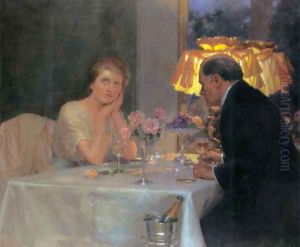Albert Collings Paintings
Albert Collings was a British painter and illustrator born in 1893, whose work, though not widely known in the mainstream art world, holds a significant place in the annals of early 20th-century British art. His artistic journey commenced in the bustling atmosphere of pre-war London, where he was exposed to the burgeoning movements that defined the era. He studied at various art institutions, absorbing the influences of Impressionism, Post-Impressionism, and the emerging modernist tendencies of his time. Despite the shadow of World War I, which disrupted many artists' careers, Collings managed to continue his artistic pursuits, albeit with the inevitable interruptions and challenges the war presented.
Throughout the 1920s and 1930s, Albert Collings developed a distinctive style that blended traditional British landscape painting with the more avant-garde approaches of modernism. His landscapes and urban scenes capture the changing face of Britain, reflecting both the beauty of its countryside and the dynamic, sometimes harsh realities of urban life. He experimented with color and form, sometimes leaning towards abstraction, yet always maintaining a strong connection to the subject matter.
Collings was also a prolific illustrator, contributing to various magazines and books of the time. His illustrations often carried a whimsical or satirical tone, showcasing his keen observations of society and a subtle critique of its follies. Despite his talents, he never achieved the level of fame or recognition enjoyed by some of his contemporaries. The reasons for this are varied, including possibly his own reticence to engage with the commercial art world, as well as the overshadowing impact of World Wars and the interwar period on the careers of many artists.
The outbreak of World War II and the subsequent post-war period marked a difficult phase for Collings, as it did for many artists. The war's impact on society and the art world was profound, leading to new movements and changes in public taste that did not always align with Collings' work. Despite these challenges, he continued to paint and illustrate until his death in 1951. Today, Albert Collings' contributions to British art are being slowly rediscovered and appreciated anew. His body of work offers a unique window into the transitional period of British art, straddling the traditional and the modern, and reflecting the tumultuous social and cultural shifts of his time.
